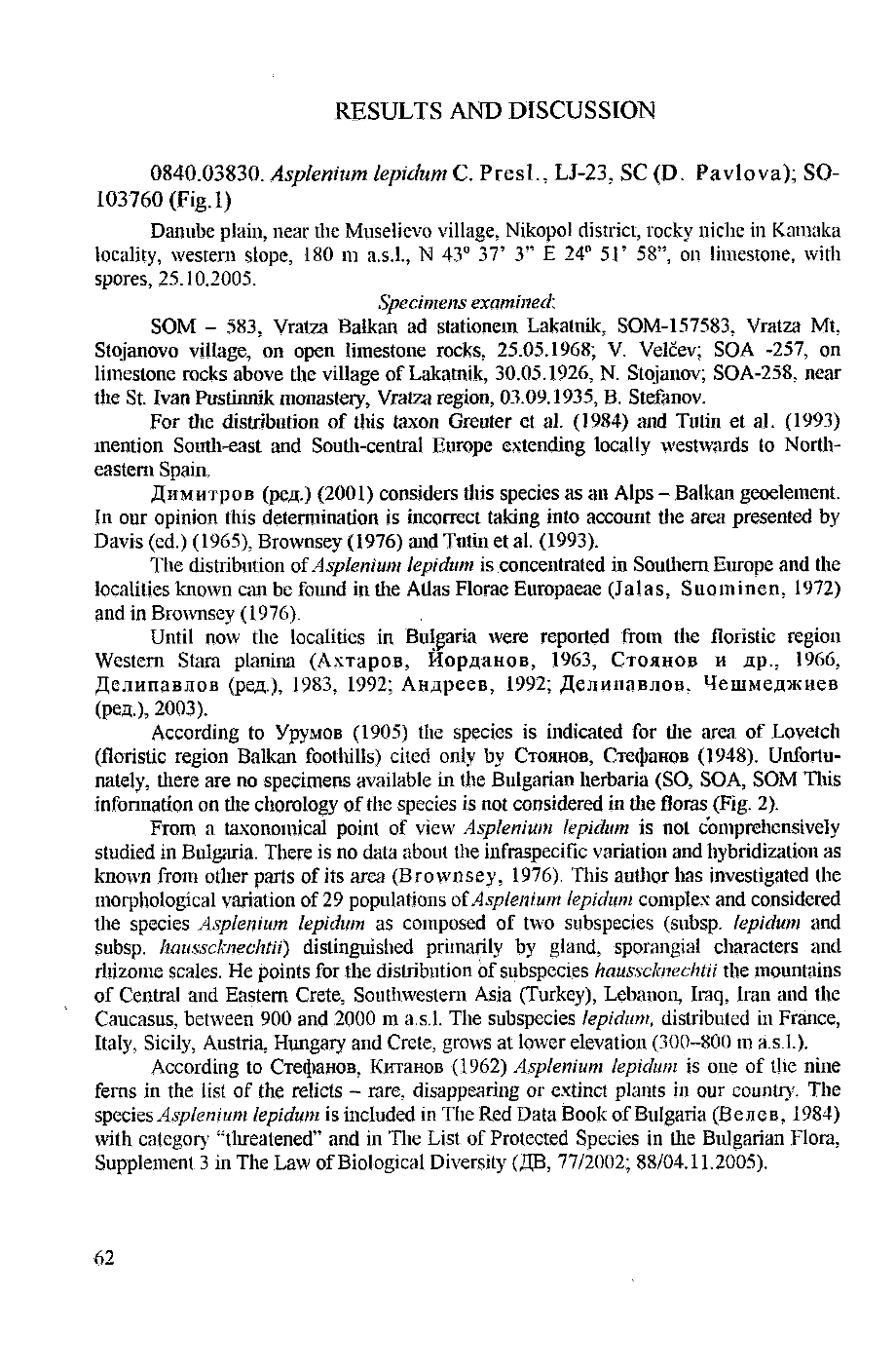

RESULTS AND DISCUSSION
0840.03830.
A sp len ium lep idum
C. P resl., LJ-23, SC (D. Pavlova); SO-
103760 (Fig. 1)
Danube plain, near the Miiselievo village, Nikopol district, rocky niche in Kainaka
locality, western slope, 180 m a.s.l., N 43° 37’ 3" E 24° 5 Г 58", on limestone, with
spores, 25.10.2005.
Specimens examined
;
SOM - 583, Vratza Balkan ad stationem Lakalnik, SOM-157583, Vratza Mt,
Stojanovo village, on open limestone rocks, 25.05.1968; V. Velcev; SOA -257, on
limestone rocks above the village o f Lakatnik, 30.05.1926, N. Stojanov; SOA-258, near
the St Ivan Pustinmk monastery, Vratza region, 03.09.1935, B. Stefanov.
For the distribution of this taxon Greuter et al. (1984) and Tulin et al. (1993)
mention South-east and South-central Europe extending locally westwards to North
eastern Spain,
Димитров (ред.) (2001) considers this species as an Alps - Balkan geoelement.
In our opinion this determination is incorrect taking into account the area presented by
Davis (ed.) (1965), Brownsey (1976) and Tutin et al. (1993).
The distribution of
Asplenium lepidum
is concentrated in Southern Europe and the
localities known can be found in the Allas Florae Europaeae (Jalas, Suom inen , 1972)
and in Brownsey (1976).
Until now the localities in Bulgaria were reported from the floristic region
Western Stara planina (Ахтаров , Й орданов , 1963, Стоянов и д р ,: 1966,
Д елипавлов (ред.), 1983, 1992; Андреев , 1992; Д елипавлов , Чешмеджиев
(ред.), 2003).
According to Урумов (1905) the species is indicated for the area of Eovetch
(floristic region Balkan foothills) cited only by Стоянов, Стефанов (1948). Unfortu
nately, there are no specimens available in the Bulgarian herbaria
(SO, SOA, SOM
This
information on the chorology o f the species is not considered in die floras (Fig. 2).
From a taxonomical point of view
Asplenium lepidum
is not comprehensively
studied in Bulgaria. There is no data about Hie infraspecific variation and hybridization as
known from other parts of its area (B rown sey, 1976). This author has investigated the
morphological variation of 29 populations of
Asplenium lepidum
complex and considered
the species
Asplenium lepidum
as composed of two subspecies (subsp.
lepidum
and
subsp.
hamscknechtii)
distinguished primarily by gland, sporangial characters and
rhizome scales. He points for the distribution of subspecies
hausscknechtii
the mountains
of Central and Eastern Crete, Southwestern Asia (Turkey), Lebanon, Iraq, Iran and the
Caucasus, between 900 and 2000 m a.s.l. The subspecies
lepidum
, distributed in France,
Italy, Sicily, Austria, Hungary and Crete, grows at lower elevation (300-800 m a.s.l.).
According to Стефанов, Китанов (1962)
Asplenium lepidum
is one of the nine
ferns in the list of the relicts - rare, disappearing or extinct plants in our country. The
species
Asplenium lepidum
is included in The Red Data Book o f Bulgaria (Велев, 1984)
with category' “threatened” and in The List of Protected Species in the Bulgarian Flora,
Supplement 3 in The Law of Biological Diversity (ДВ, 77/2002; 88/04.11,2005).
62
Электронная Научная СельскоХозяйственная Библиотека









